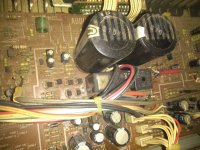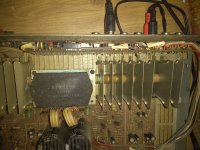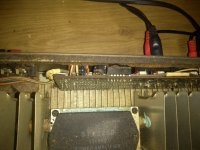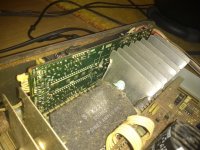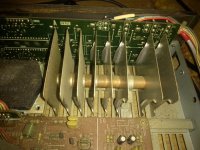Hi guys, I'm new around here.
I have a problem with an old amplifier that I inherited from my father, it is the sony ta-ax44.
I use it mainly to listen to some vinyl records but I have the problem that the rec out does not work. When i connect the output rca cable, I see some small sparks come out in the channel mass, and this causes the signal to clip and a protection click is heard inside the amplifier.
After moving the rca connector for a while, I managed to make it sound on both channels well when i push the mass of the rca connector so it touches the chassis, but as soon as I released and stopped pressing the conector, this would work badly again.
I have a welder, so I've opened it in case the welds were cold and I have not seen anything strange.
maybe someone can guide me, as i think it should be pretty simple to repair.
I have a problem with an old amplifier that I inherited from my father, it is the sony ta-ax44.
I use it mainly to listen to some vinyl records but I have the problem that the rec out does not work. When i connect the output rca cable, I see some small sparks come out in the channel mass, and this causes the signal to clip and a protection click is heard inside the amplifier.
After moving the rca connector for a while, I managed to make it sound on both channels well when i push the mass of the rca connector so it touches the chassis, but as soon as I released and stopped pressing the conector, this would work badly again.
I have a welder, so I've opened it in case the welds were cold and I have not seen anything strange.
maybe someone can guide me, as i think it should be pretty simple to repair.
Attachments
I'm presently working on a TA-AX44 amp to try and bring it back to life. I can tell you this: it's not a simple beast inside at all, and repairing all but the most straightforward issues may be impossible. Many of the more unusual active components are no longer made or available (even used), and substitutes are not perfect. If one of those components has gone, the whole amp may be a goner.
Your protection click is probably coming from the DPST 24VDC relay on the main board, which is activated by a sub-circuit which senses when an output load (speaker or headphones) is physically connected and connects the output load to the amp after it's settled down from initial power-on. That sub-circuit causes a lot of grief for people, myself included, and uses Japanese transistors (no longer available) in a Darlington pair configuration to toggle the relay.
If you can be a bit more precise, I'll try to give you some insight as to what could be the problem, but right now it's a bit difficult for me to comment further without more info.
Your protection click is probably coming from the DPST 24VDC relay on the main board, which is activated by a sub-circuit which senses when an output load (speaker or headphones) is physically connected and connects the output load to the amp after it's settled down from initial power-on. That sub-circuit causes a lot of grief for people, myself included, and uses Japanese transistors (no longer available) in a Darlington pair configuration to toggle the relay.
If you can be a bit more precise, I'll try to give you some insight as to what could be the problem, but right now it's a bit difficult for me to comment further without more info.
Hey, thank you for your reponse and your time.I'm presently working on a TA-AX44 amp to try and bring it back to life. I can tell you this: it's not a simple beast inside at all, and repairing all but the most straightforward issues may be impossible. Many of the more unusual active components are no longer made or available (even used), and substitutes are not perfect. If one of those components has gone, the whole amp may be a goner.
Your protection click is probably coming from the DPST 24VDC relay on the main board, which is activated by a sub-circuit which senses when an output load (speaker or headphones) is physically connected and connects the output load to the amp after it's settled down from initial power-on. That sub-circuit causes a lot of grief for people, myself included, and uses Japanese transistors (no longer available) in a Darlington pair configuration to toggle the relay.
If you can be a bit more precise, I'll try to give you some insight as to what could be the problem, but right now it's a bit difficult for me to comment further without more info.
Yes, i've been thinking that if i cant repair it myself without buying parts, it will go to rubbish (so sad).
The only load that i'm using is the line-output from the "rec out" to the computer. The left channel's mass shows some sparks when it touches the external chassis, but the sound never comes in a good way. I can try to record a video and share to you. Would that be ok? Thank you!
My first thoughts on this are that the sparks are caused by the computers SMPS (switching power supply). It is not that uncommon an effect between certain types of equipment. That's my first thought.
The Sony was designed long before we used PC's and similar equipment and so I wonder if the sparking has damaged the internal chip that does the switching and processing.
If pushing and pulling the RCA socket alters the fault then you have a physically problem somewhere. Make sure the soldering good on the sockets.
The Sony was designed long before we used PC's and similar equipment and so I wonder if the sparking has damaged the internal chip that does the switching and processing.
If pushing and pulling the RCA socket alters the fault then you have a physically problem somewhere. Make sure the soldering good on the sockets.
No worries. Try plugging in a pair of headphones and see what you get.Hey, thank you for your reponse and your time.
Yes, i've been thinking that if i cant repair it myself without buying parts, it will go to rubbish (so sad).
The only load that i'm using is the line-output from the "rec out" to the computer. The left channel's mass shows some sparks when it touches the external chassis, but the sound never comes in a good way. I can try to record a video and share to you. Would that be ok? Thank you!
Comments made after mine have given you some other ideas as to what the problem could be, and several possibilities to check. The RCA inputs/outputs are all tied to a single secondary board at the back of the amp, and you can't get access to that board to check soldering joints without first unscrewing the heatsink assembly for the STK2240 power amp module and gently levering it up and back towards the front of the amp (you may have to snip one or two cable bundle ties to make this work). Then you can unscrew the input/output board from the amp's rear and move it up and away from the back of the amp so you can see what's what (and do some soldering if that's the problem). That's what I had to do, anyways — it's kinda tight in there.
If the problem is in the detection/protection circuits, the original transistors are no longer available, but there do appear to be some modern replacements which will do the job. Specifically, the 2SC1364 NPN transistors (comprising Q501-503 and Q507-510) can be replaced with modern KSC2383 transistors if needed (in fact, the modern trannies have better current handling capability and higher voltage ratings), and Q305 (a 2SA1049 PNP which does the speaker detection) can be replaced by a modern ZTX795A (again with better current handling and max voltage specs). In particular, the 2SC1364 transistor is reputed to be somewhat "flaky" as it ages, and can even test "good" when it actually needs replacement! In all cases, the pin-outs for the modern versions are different than for the original Japanese trannies, so be aware that you'll have to cross a couple of leads (so one of them will need to be insulated).
When I removed Q509 to check it (because it was showing test voltage readings that were wildly off from what the Service Manual claimed should be present), I'd found that the factory had used 2SC945 trannies instead of the manual's 2SC1364, which might have contributed to failure (the 945 has slightly less robusts specs for current-handling and max voltage).
As an aside, the amp's also littered with 1S1555 small-signal diodes (one's put right across the DC terminals of the 24V relay), another Japanese specialty no longer available, but a perfectly adequate replacement is the 1N4148 diode, which once again has better reverse-voltage capabilities than the original 1S1555. 1N4148s are also dirt cheap.
No worries. Try plugging in a pair of headphones and see what you get.
Comments made after mine have given you some other ideas as to what the problem could be, and several possibilities to check. The RCA inputs/outputs are all tied to a single secondary board at the back of the amp, and you can't get access to that board to check soldering joints without first unscrewing the heatsink assembly for the STK2240 power amp module and gently levering it up and back towards the front of the amp (you may have to snip one or two cable bundle ties to make this work). Then you can unscrew the input/output board from the amp's rear and move it up and away from the back of the amp so you can see what's what (and do some soldering if that's the problem). That's what I had to do, anyways — it's kinda tight in there.
If the problem is in the detection/protection circuits, the original transistors are no longer available, but there do appear to be some modern replacements which will do the job. Specifically, the 2SC1364 NPN transistors (comprising Q501-503 and Q507-510) can be replaced with modern KSC2383 transistors if needed (in fact, the modern trannies have better current handling capability and higher voltage ratings), and Q305 (a 2SA1049 PNP which does the speaker detection) can be replaced by a modern ZTX795A (again with better current handling and max voltage specs). In particular, the 2SC1364 transistor is reputed to be somewhat "flaky" as it ages, and can even test "good" when it actually needs replacement! In all cases, the pin-outs for the modern versions are different than for the original Japanese trannies, so be aware that you'll have to cross a couple of leads (so one of them will need to be insulated).
When I removed Q509 to check it (because it was showing test voltage readings that were wildly off from what the Service Manual claimed should be present), I'd found that the factory had used 2SC945 trannies instead of the manual's 2SC1364, which might have contributed to failure (the 945 has slightly less robusts specs for current-handling and max voltage).
As an aside, the amp's also littered with 1S1555 small-signal diodes (one's put right across the DC terminals of the 24V relay), another Japanese specialty no longer available, but a perfectly adequate replacement is the 1N4148 diode, which once again has better reverse-voltage capabilities than the original 1S1555. 1N4148s are also dirt cheap.
Thank you, i've been doing some test, i found this:
Can you see the mass channel from the red one?
I have lifted that tab, the ground of the RCA so that it makes contact with the chassis, at that moment, a small spark comes out, the "click" sounds inside the amp, at the same time, the loudspeakers emit a "pop" and then it works fine.
If i don't do this, the problem is that the sound is very noisy and low.
Maybe it's because of the computer I'm connecting it to? It's a Saffire Focusrite sound card.
The amp itself is fried, I only use the phono preamp because honestly, it's very good quality.
Maybe the problem is the ground is coming into the channel somehow and when i do that i filter it? The turntable is correctly grounded to the sony chasis, the screw that is just apart from the phono input.
Edit: Oh i got a question for you. What you think about this phono preamp? It sound really good but i didn't see any technical analysis. I've been wondering if u think that its possible to take out the phono circuitry and "create" a new chasis so it holds only the phono + psu part, and i don't really need the stereo amp since its not as good as the phono preamp or that's what i think + low wattage (almost useless). I can do a custom chasis so the pieces could fit properly but i need help on which parts are necessary and what not, apart from the obvious (psu, input/ouput boards...)
THx
Last edited:
The chassis is of course negative ground for the amp itself, so if there's B+ on the centre pin of the RCA connector, you're completing a connection somewhere, but I don't know anything about your soundcard, so... It's odd that the relay seems to be kicking in because of that, but mebbe the contacts of the relay have become sticky over decades and need cleaning, and you're giving it an additional high-current pulse that overcomes the stickiness and allows the relay to connect the audio path to the output circuitry (although it shouldn't be affecting the line-out stuff as far as I can tell from the schematics). It's strange behaviour, to be sure.
As for the idea of gutting the amp and salvaging the pre-amp section and the PSU, while I admire your courage, I think that would be more trouble than it's worth. You can buy pre-amps for around $20.00 USD including shipping off of places like AliExpress (like the AU-10X, based on the 5532 op amp, which is an excellent low-noise small-signal audio amplifier) that will equal the performance of the pre-amp in the AX44, and trying to save and re-purpose the PSU for just the ASP (Audio Signal Processor) chip and its related circuitry would be a royal pain IMNSHO. For one thing, the power supply's wildly over-spec'ed for the simple purpose of just powering the ASP, and your resulting unit would weigh a lot (and be absurdly large for just a pre-amp). The big electrolytic filters are probably on their last legs (mine were domed on top when I first cracked the unit open, so they've been replaced), and it's likely that other 'lytics will need replacing as well (I just re-capped everything as a matter of course).
If it was me, I'd harvest all the good stuff inside the chassis (that power transformer's worth a fortune! and the heat sink assembly's no slouch), junk or recycle the remainder and get a small modern pre-amp and run it off of batteries to minimize noise in the signal path.
If you're going the AU-10X route, I recommend cracking the case open (it's all-metal and can be unscrewed) and replacing all the 'lytics inside, 'cause the ones they use are off-brand Chinese junk. Putting some quality 'lytics in dropped the background hiss to the point where I could barely hear it even on headphones.
Good luck!
As for the idea of gutting the amp and salvaging the pre-amp section and the PSU, while I admire your courage, I think that would be more trouble than it's worth. You can buy pre-amps for around $20.00 USD including shipping off of places like AliExpress (like the AU-10X, based on the 5532 op amp, which is an excellent low-noise small-signal audio amplifier) that will equal the performance of the pre-amp in the AX44, and trying to save and re-purpose the PSU for just the ASP (Audio Signal Processor) chip and its related circuitry would be a royal pain IMNSHO. For one thing, the power supply's wildly over-spec'ed for the simple purpose of just powering the ASP, and your resulting unit would weigh a lot (and be absurdly large for just a pre-amp). The big electrolytic filters are probably on their last legs (mine were domed on top when I first cracked the unit open, so they've been replaced), and it's likely that other 'lytics will need replacing as well (I just re-capped everything as a matter of course).
If it was me, I'd harvest all the good stuff inside the chassis (that power transformer's worth a fortune! and the heat sink assembly's no slouch), junk or recycle the remainder and get a small modern pre-amp and run it off of batteries to minimize noise in the signal path.
If you're going the AU-10X route, I recommend cracking the case open (it's all-metal and can be unscrewed) and replacing all the 'lytics inside, 'cause the ones they use are off-brand Chinese junk. Putting some quality 'lytics in dropped the background hiss to the point where I could barely hear it even on headphones.
Good luck!
The chassis is of course negative ground for the amp itself, so if there's B+ on the centre pin of the RCA connector, you're completing a connection somewhere, but I don't know anything about your soundcard, so... It's odd that the relay seems to be kicking in because of that, but mebbe the contacts of the relay have become sticky over decades and need cleaning, and you're giving it an additional high-current pulse that overcomes the stickiness and allows the relay to connect the audio path to the output circuitry (although it shouldn't be affecting the line-out stuff as far as I can tell from the schematics). It's strange behaviour, to be sure.
As for the idea of gutting the amp and salvaging the pre-amp section and the PSU, while I admire your courage, I think that would be more trouble than it's worth. You can buy pre-amps for around $20.00 USD including shipping off of places like AliExpress (like the AU-10X, based on the 5532 op amp, which is an excellent low-noise small-signal audio amplifier) that will equal the performance of the pre-amp in the AX44, and trying to save and re-purpose the PSU for just the ASP (Audio Signal Processor) chip and its related circuitry would be a royal pain IMNSHO. For one thing, the power supply's wildly over-spec'ed for the simple purpose of just powering the ASP, and your resulting unit would weigh a lot (and be absurdly large for just a pre-amp). The big electrolytic filters are probably on their last legs (mine were domed on top when I first cracked the unit open, so they've been replaced), and it's likely that other 'lytics will need replacing as well (I just re-capped everything as a matter of course).
If it was me, I'd harvest all the good stuff inside the chassis (that power transformer's worth a fortune! and the heat sink assembly's no slouch), junk or recycle the remainder and get a small modern pre-amp and run it off of batteries to minimize noise in the signal path.
If you're going the AU-10X route, I recommend cracking the case open (it's all-metal and can be unscrewed) and replacing all the 'lytics inside, 'cause the ones they use are off-brand Chinese junk. Putting some quality 'lytics in dropped the background hiss to the point where I could barely hear it even on headphones.
Good luck!
Thanks for your reply and sorry for my late response.
I've been doing some tests. In the first picture u can see the relay that causes the "click" when the ground cable touches the chasis. Currently it only sounds one of the channel, when i touch the output (positive), the relay activates and the sound is good on that channel,the other channel makes a noise too but it doesn't work at all.
I put a video with the testings i did, i feel like i'm very near the answer. U can watch it online, it's not necessary to download it.
https://mega.nz/file/u5pwRDia#pnB1TivDCZYlk09oAv2VzKmymAlf9aWgNP31bc2vK9Y
Attachments
I suspect that your protection relay is borked. (It's quite common.) Decades after assembly, it's unrealistic to expect a relay's contacts to work flawlessly.Thanks for your reply and sorry for my late response.
I've been doing some tests. In the first picture u can see the relay that causes the "click" when the ground cable touches the chasis. Currently it only sounds one of the channel, when i touch the output (positive), the relay activates and the sound is good on that channel,the other channel makes a noise too but it doesn't work at all.
I put a video with the testings i did, i feel like i'm very near the answer. U can watch it online, it's not necessary to download it.
https://mega.nz/file/u5pwRDia#pnB1TivDCZYlk09oAv2VzKmymAlf9aWgNP31bc2vK9Y
You can try disassembling and cleaning the relay, but a replacement may be in order. I'd be tempted to first bypass the relay on the "dead" channel and see if it works. Be careful, it's tight in there, and one wrong connection (even momentary) can fry something you'd rather not.
As for my amp, I had to gut and salvage it -- the output thick-film hybrid IC was trashed, and any replacement I could find was unlikely to actually work. No biggie -- I only paid $20 CDN for it, and the transformer alone's probably worth around a hundo.
Good luck!
- Home
- Amplifiers
- Chip Amps
- Problem rec out Sony TA-AX44
